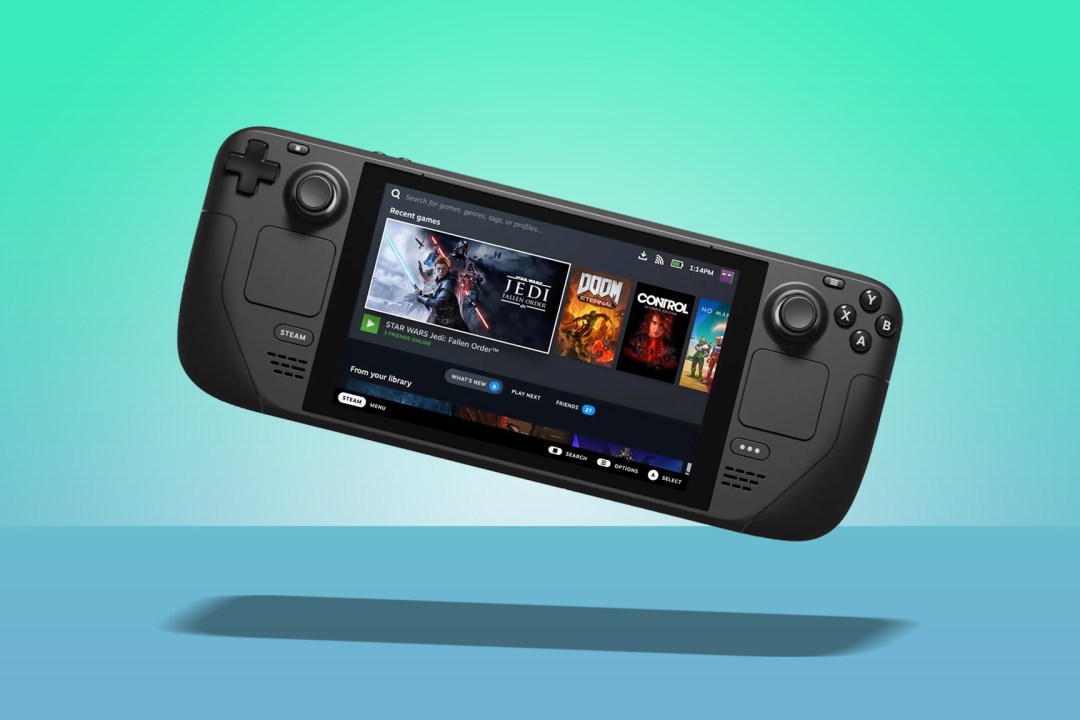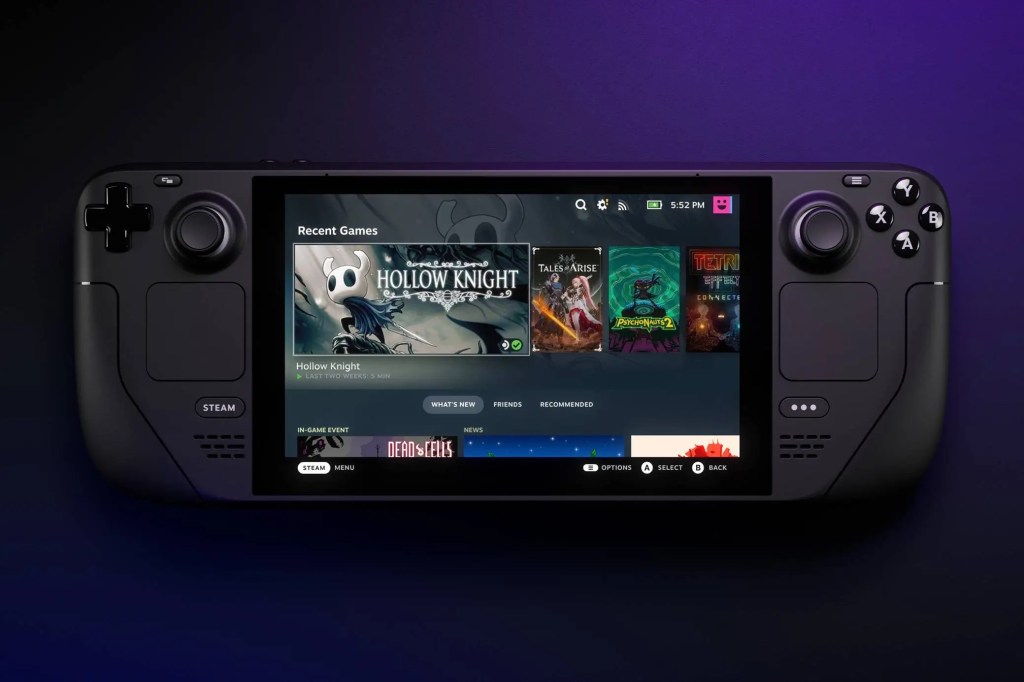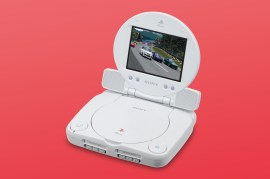Steam Deck 2: the features we want from Valve’s next gaming handheld
The Steam Deck is a solid piece of kit. Can Valve do even better?

By most estimations, Valve should be very happy with the near-universal praise heaped on its first ever handheld console.
Sorry, make that handheld PC: the Steam Deck doesn’t just take your Steam library on the move, it’ll play titles from other digital stores, emulate classics and makes a fine substitute for a laptop with minimal tinkering. But that doesn’t mean there aren’t improvements to be made, should a Steam Deck 2 ever hit the shelves.
And why wouldn’t it? The original was in such demand Valve had to initially restrict supply, and its popularity has seen games devs embrace Linux (the back-end operating system that powers the Steam Deck’s UI) like never before. The Steam Deck OLED fixed gamers’ few issues with the original device, with a brighter display and better battery life.
But Valve’s competitors are multiplying, with firms both mainstream and boutique popping up with their own take on the game-friendly handheld. They’re getting quite good, too, as we saw with Asus’ recent ROG Ally X.
Valve will almost certainly want to cement its lead with a follow-up device – when the time is right. Before it does, we’ve thought of a few ways a Steam Deck successor could improve on today’s model.
Steam Deck 2: is it actually happening?

Yes. All signs are certainly pointing that way, anyway. Following the Steam Deck OLED’s reveal, Valve Product Designer Lawrence Yang confirmed to Bloomberg that the next Steam Deck would get a “next-generation” power boost. He also said we wouldn’t be seeing it for at least two or three years.
Around the same time, Valve hardware engineer Yazan Aldehayyat told Eurogamer the firm would “love to get even more performance in the same power envelope” as the current model, but “that technology doesn’t exist yet”.
Valve had previously called the Steam Deck a multi-generational product, suggesting that it would evolve in some way. Now it has boosted battery life and added an improved screen, performance is the obvious next step.
In an earlier 2022 interview with The Verge, Steam Deck designer Pierre-Loup Griffais said Valve was deliberating on whether to keep the handheld’s performance consistent for the time being.
“Right now the fact that all the Steam Decks can play the same games and that we have one target for users to understand what kind of performance level to expect when you’re playing and for developers to understand what to target… there’s a lot of value in having that one spec,” Griffais said. “I think we’ll opt to keep the one performance level for a little bit longer, and only look at changing the performance level when there is a significant gain to be had.”
Steam Deck 2 likely release date

We’ve known that Valve is working on a Steam Deck 2 for a while now. Company co-founder Gabe Newell confirmed as much in an interview with Edge Magazine, saying a new Deck would focus on “the capabilities that mobile gives us, above and beyond what you would get in a traditional desk or laptop gaming environment.” But when, exactly?
Circle 2025 in your diaries – that’s the most likely candidate for a full Steam Deck 2 release.
Unlike the smartphone world, which is tied to an annual release cycle, the PC hardware market tends to move at a slower pace. Valve won’t want to launch a Steam Deck successor until there’s a new generation of APU (the combined processor and graphics chip doing all the heavy lifting when it comes to games) available with significantly more performance.
The current Steam Deck uses custom AMD silicon based on the firm’s 7nm RDNA 2 architecture, which was first announced in 2020 and started appearing in consumer gadgets a year later. The PS5 and Xbox Series X consoles were among the first in line, with more battery-friendly versions following later. The Steam Deck OLED got an updated version made on a 6nm process, which improves power efficiency but doesn’t offer any power gains.
RDNA 2’s successor, the imaginatively named RDNA 3, made its debut in November 2022 inside AMD’s latest high-end PC graphics cards. Beyond a general power hike, improvements include a 50% increase in performance-per-watt over the previous generation and adaptive power management – seemingly making it the obvious choice for any Steam Deck sequel.
However, recent Valve comments suggest there’s not a big enough leap from the existing silicon to justify a full Steam Deck 2.0. That means a new generation of chips will have to arrive, pushing us into 2024 and beyond. By the time Valve gets its hands on the hardware, develops a handheld around it and puts it into production, 2025 is the earliest realistic date.
- Related: 12 of the best budget Steam games
Steam Deck 2 possible price
Bargain hunters may not be too thrilled to hear the most popular version of the Steam Deck is the most expensive one – and Gabe Newell suggests the company has taken that as customers willing to spend even more should it release a more expensive version.
It stands to reason, then, that the $349/£349 entry price might not stick around for a second generation. Valve could instead move the goalposts, making the current $549/£479 mid-range model the new entry-level, and introducing an even pricier tier above the current $649/£569 flagship.
Happily the new Steam Deck OLED hasn’t brought a major price bump, despite component costs being on the rise (as well as the general cost of living). Still, that doesn’t mean the next generation Steam Deck won’t be more expensive – only that right now the exact amount would be pure guesswork.
Steam Deck 2 feature wish list

We awarded the Steam Deck four stars in our review, singing the praises of its astounding performance, intuitive UI and endlessly customisable controls. A host of software updates has worked out some of the kinks, but there’s still room to improve. Look no further than the following suggestions of what we’d like to see in a successor to work out what would have raised that score to the full five stars.
Longer battery life
We’ll get the obvious improvement out of the way first. Unless you’re using the OG Steam Deck to play 8-bit classics at the lowest brightness setting and with all the internal hardware turned down to its lowest level, it isn’t fantastic in terms of battery life. Steam says you should see anywhere between two and eight hours of game time, but that makes for a pretty wide margin.
In reality, three or four hours is a fairly common benchmark, and it’s not uncommon for the Steam Deck to make it to around 90 minutes in the most demanding titles before throwing in the towel. As the primary gripe of Steam Deck gamers, fixing this issue would be a major crowdpleaser – either with a bigger battery, or more energy-efficient components.
The Steam Deck OLED fixed this to a degree, promising a 30-50% battery life improvement thanks to a more efficient display and larger 50wHr battery pack. But when you’re absorbed in a new game, the last thing you want to see is a low battery alert – we’ll happily take even more life away from the mains from a Steam Deck 2.0.
A better OLED display
Valve followed in the footsteps of Nintendo and made the switch to an OLED display for the Steam Deck’s mid-life refresh. It’s larger, brighter, more colourful, adds HDR support, and has a higher 90Hz refresh rate; even at the same 1280×800 resolution, the combo makes the original model’s 7in LCD look beyond basic in comparison.
How to improve on that for a full sequel? A Full HD panel would be nice, even if it adds more strain to the APU and drain the battery even faster. Instead, we’d like to see a 120Hz variable refresh rate panel, akin to Nvidia G-Sync or AMD Freesync on a desktop PC monitor, which could play games smoothly at less than 60fps or give less demanding titles a smoother appearance.
Up the accessibility
Accessibility in gaming, although slow moving, is getting better as more developers aim to make their games enjoyable for everyone. Valve could do its part to help in a few ways. First off, there are too many games with tiny text and no way to resize them: offering a way of changing hardware-level text sizes would make games far more legible on the Steam Deck’s small screen.
The Steam Deck is also very big. Even the lighter OLED model is over double the weight of the standard Nintendo Switch, which comes in at 299g. That’s a problem for people with motor disabilities, so trimming some of that weight down should be a top priority.
To Steam’s credit, they are addressing some of the accessibility issues. Steam Input, a service that allows any controller to be linked to a device, works well on the Deck and opens up a world of customisable accessible control schemes for many players. Steam could also release updates to some of the issues we’ve raised above, too. But for the Steam Deck 2, a greater emphasis on accessibility will edge it much closer to being a perfect handheld console PC.
Time for a Steam controller rebirth?
Once upon a time (2015 to be exact), Valve experimented with the idea of a Steam controller. It sported dual trackpads for PC gaming, dual-stage triggers and haptics that allowed you to ‘feel the spin of a virtual trackball, the click of a scroll wheel, or the shot of a rifle’, said Valve at the time.
But the Steam controller ran out of, well, steam, and was discontinued after four years. A downside to the Steam Deck, though, is its inability to fully adapt to games that are best played with a mouse and keyboard. This isn’t a problem unique to the Steam Deck, but a Valve-certified controller built specifically for the handheld would be a great addition. It could even up the vibration, and have some improved ventilation while we’re at it. The Steam Deck haptics leave much to be desired, so let’s update that while we’re at it.


